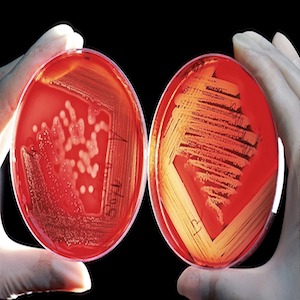Effectiveness of essential oils against dual-species biofilm of Listeria monocytogenes and Pseudomonas fluorescens in a Ricotta-based model system

Accepted: 13 February 2023
HTML: 9
All claims expressed in this article are solely those of the authors and do not necessarily represent those of their affiliated organizations, or those of the publisher, the editors and the reviewers. Any product that may be evaluated in this article or claim that may be made by its manufacturer is not guaranteed or endorsed by the publisher.
Biofilms represent an evolutionary form of life, which translates from life in free-living cells to a community lifestyle. In natural habitats, biofilms are a multispecies complex, where synergies or antagonisms can be established. For example, Listeria monocytogenes and Pseudomonas fluorescens are associated with a dual-species biofilm that is widespread in dairy plants. In food plants, multiple strategies are devised to control biofilms, including natural compounds such as essential oils (EOs). In this respect, this study evaluated the effectiveness of Thymbra capitata (L.) Cav. EO and Cinnamomum zeylanicum (CEO) against a dual-species biofilm of L. monocytogenes and P. fluorescens, mimicking dairy process conditions. Based on Minimum Inhibitory Concentrations results, the EOs concentration (10 µL/mL) was chosen for the antibiofilm assay at 12°C on polystyrene (PS), and stainless steel surfaces for 168 h, using a Ricotta-based model system as culture medium. Biofilm biomass was assessed by crystal violet staining, and the planktonic and sessile cells were quantified in terms of Log CFU/cm2. Results showed that CEO displayed the greatest antibiofilm activity, reducing significantly (P<0.05) P. fluorescens and L. monocytogenes sessile cells of about 2.5 and 2.8 Log CFU/cm2 after 72 h, respectively. However, L. monocytogenes gained the protection of P. fluorescens, evading CEO treatment and showing a minimal sessile cell reduction of 0.7 Log CFU/cm2 after 72 h. Considering the outcome of this study, CEO might have promising perspectives for applications in dairy facilities.
Aswathanarayan JB, Vittal RR, 2014. Attachment and biofilm formation of Pseudomonas fluorescens PSD4 isolated from a dairy processing line. Food Sci Biotechnol 23:1903–10. DOI: https://doi.org/10.1007/s10068-014-0260-8
Burt S, 2004. Essential oils: their antibacterial properties and potential applications in foods-a review. Int J Food Microbiol 94:223-53. DOI: https://doi.org/10.1016/j.ijfoodmicro.2004.03.022
CLSI, 2016. Performance Standards for Antimicrobial Susceptibility Testing. 26th ed. CLSI 448 supplement M100S.
de Carvalho RJ, de Souza GT, Honório VG, de Sousa JP, da Conceição ML, Maganani M, de Souza EL, 2015. Comparative inhibitory effects of Thymus vulgaris L. essential oil against Staphylococcus aureus, Listeria monocytogenes and mesophilic starter co-culture in cheese-mimicking models. Food Microbiol 52:59-65. DOI: https://doi.org/10.1016/j.fm.2015.07.003
Dos Santos Rodrigues JB, de Souza NT, Scarano JOA, de Sousa JM, Lira MC, de Figueiredo RCBQ, Magnani M, 2018. Efficacy of using oregano essential oil and carvacrol to remove young and mature Staphylococcus aureus biofilms on food-contact surfaces of stainless steel. LWT 93:293-9. DOI: https://doi.org/10.1016/j.lwt.2018.03.052
EFSA, 2022. The European Union One Health 2020 zoonoses report. EFSA J 19:6971. DOI: https://doi.org/10.2903/j.efsa.2021.6971
Ferreira V, Wiedmann M, Teixeira P, Stasiewicz MJ, 2014. Listeria monocytogenes persistence in food-associated environments: epidemiology, strain characteristics, and implications for public health. J Food Prot 77:150-70. DOI: https://doi.org/10.4315/0362-028X.JFP-13-150
Hyldgaard M, Mygind T, Meyer R, 2012. Essential Oils in Food Preservation: Mode of Action, Synergies, and Interactions with Food Matrix Components. Front Microbiol 3:1-12. DOI: https://doi.org/10.3389/fmicb.2012.00012
Lee JL, Jung M, Lee SC, Huh MJ, Seo SL, Park IK, 2020. Antibacterial mode of action of trans-cinnamaldehyde derived from cinnamon bark (Cinnamomum verum) essential oil against Agrobacterium tumefaciens, Pestic Biochem Phys 165:104546. DOI: https://doi.org/10.1016/j.pestbp.2020.02.012
Maggio F, Rossi C, Chaves-López C, Serio A, Valbonetti L, Pomilio F, Chiavaroli AP, Paparella A, 2021. Interactions between L. monocytogenes and P. fluorescens in dual-species biofilms under simulated dairy processing conditions. Foods 10:1-16. DOI: https://doi.org/10.3390/foods10010176
Martins M, Uelinton MP, Katharina R, Vanetti MD, 2015. Milk-deteriorating exoenzymes from Pseudomonas fluorescens 041 isolated from refrigerated raw milk. Braz J Microbiol 46:207-17. DOI: https://doi.org/10.1590/S1517-838246120130859
Melo J, Andrew PW, Faleiro MI, 2015. Listeria monocytogenes in cheese and the dairy environment remains a food safety chal-lenge: the role of stress responses. Food Res Int 67:75-90. DOI: https://doi.org/10.1016/j.foodres.2014.10.031
Nava D, Capo S, Caligiuri V, Giaccone V, Biondi L, Vaccaro GF, Guarino A, Capuano F, 2016. Study of the population dynamics of Listeria monocytogenes and Pseudomonas fluorescens in buffalo mozzarella by means of challenge testing. Ital J Food Saf 5:5690. DOI: https://doi.org/10.4081/ijfs.2016.5690
Paparella A, Mazzarrino G, Chaves-López C, Rossi C, Sacchetti G, Guerrieri O, Serio A, 2016. Chitosan boosts the anti-microbial activity of Origanum vulgare essential oil in modified atmosphere packaged pork. Food Microbiol 59:23-31. DOI: https://doi.org/10.1016/j.fm.2016.05.007
Puga CH, Dahdouh E, SanJose C, Orgaz B, 2018. Listeria monocytogenes colonizes Pseudomonas fluorescens biofilms and induces matrix over-production. Front Microbiol 9:1-12. DOI: https://doi.org/10.3389/fmicb.2018.01706
Rao J, Chen B, Julian D, Clements MC, 2019. Improving the Efficacy of Essential Oils as Antimicrobials in Foods: Mechanisms of Action. Annu Rev Food Sci T 10:365-87. DOI: https://doi.org/10.1146/annurev-food-032818-121727
Rossi C, Chaves-López C, Serio A, Anniballi F, Valbonetti L, Paparella A, 2018. Effect of Origanum vulgare essential oil on biofilm formation and motility capacity of Pseudomonas fluorescens strains isolated from discoloured Mozzarella cheese. J Appl Microbiol 124:1220-31. DOI: https://doi.org/10.1111/jam.13707
Rossi C, Chaves-López C, Serio A, Casaccia M, Maggio F, Paparella A, 2020. Effectiveness and mechanisms of essential oils for biofilm control on food-contact surfaces: An updated review. Crit Rev Food Sci Nutr 62:2172-91. DOI: https://doi.org/10.1080/10408398.2020.1851169
Wang Y, Hong X, Liu J, Zhu J, Chen J, 2020. Interactions between fish isolates Pseudomonas fluorescens and Staphylococcus aureus in dual-species biofilms and sensitivity to carvacrol. Food Microbiol 91:103506. DOI: https://doi.org/10.1016/j.fm.2020.103506
Zygadlo J, Zunino MP, Pizzolitto R, Merlo C, Omarini A, Dambolena J, 2017. Antibacterial and anti-biofilm activities of essential oils and their components including modes of action. Essential Oils and Nanotechnology for Treatment of Microbial Diseases, Boca Raton: CRC Press 1:112–39. DOI: https://doi.org/10.1201/9781315209241-4
Copyright (c) 2023 the Author(s)

This work is licensed under a Creative Commons Attribution-NonCommercial 4.0 International License.
PAGEPress has chosen to apply the Creative Commons Attribution NonCommercial 4.0 International License (CC BY-NC 4.0) to all manuscripts to be published.


 https://doi.org/10.4081/ijfs.2023.11048
https://doi.org/10.4081/ijfs.2023.11048



